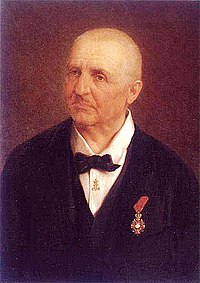| Mp3s Biography Sheetmusic | Anton Bruckner WAB 107Symphony no. 7 in ESymphony in E major. 1883. Time: 62'30. |
| Buy sheetmusic for this work at SheetMusicPlus |
Anton Bruckner's Symphony No. 7 in E major (WAB 107) is one of his best-known symphonies. It was written between 1881 and 1883 and was revised in 1885. It is dedicated to Ludwig II of Bavaria. The premiere, given under Arthur Nikisch in the opera house at Leipzig in 1884, brought Bruckner the greatest success he had known in his life. The symphony is sometimes referred to as the "Lyric", though the appellation is not the composer's own, and is seldom used.
DescriptionThe symphony has four movements:
Versions1883 versionThis was the version performed at the work's premiere. Unfortunately it survives only in one autograph copy which includes later changes by Bruckner and others, so the exact contents of this version are lost unless new manuscripts are found. This version is unpublished. 1885 versionGutmann edition (published 1885)Some changes were made after the 1884 premiere but before the first publication by Gutmann in 1885. It is widely accepted that Nikisch, Franz Schalk and Ferdinand Löwe had significant influence over this edition, but there is some debate over the extent to which these changes were authorized by Bruckner. These changes mostly affect tempo and orchestration. Haas edition (published 1944)Robert Haas attempted to remove the influence of Nikisch, Schalk and Löwe in order to retrieve Bruckner's original conception of the symphony. Haas used some material from the 1883 autograph but because this autograph also includes later changes much of his work was the product of conjecture. The most prominent feature of Haas's edition is the absence of cymbals, triangle and timpani in the slow movement: Haas asserted that Bruckner decided to omit the percussion, a claim scholar Benjamin Korstvedt deems "implausible".[4] Nowak edition (published 1954)Leopold Nowak kept most of the changes in the 1885 Gutmann edition, including the percussion. He reprinted the tempo modifications from Gutmann but placed them in brackets. Some performances of this edition omit the cymbal clash at the climax of the slow movement, although it is included in the printed score. An arrangement of this symphony for chamber ensemble (consisting of 2 violins, viola, cello, bass, clarinet, horn, piano 4-hands, and harmonium) was prepared in 1921 by students and associates of Arnold Schoenberg, for the Viennese "Society for Private Musical Performances": Hanns Eisler (1st and 3rd movements), Erwin Stein (2nd mvt.), and Karl Rankl (3rd mvt).[clarification needed] The Society folded before the arrangement could be performed, and it was not premiered until more than 60 years later. InstrumentationThe symphony requires the following orchestra:
1Used in the 2nd and 4th movements only. If Wagner Tubas are not available, they are sometimes substituted with euphoniums. 2Except the third movement where the use of timpani figures prominently, usage of percussion in the symphony is extremely limited. A timpani roll enters at the coda of the first movement. In some performance editions, the timpani re-enters along with cymbals and triangle together in the climax of the second movement (the only movement employing cymbals and triangle). (Many conductors have taken to performing the second movement without percussion, however, and the decision is generally settled by the performers' preferences.) In the last movement, the timpani rolls in brief climaxes before crescendoing with orchestral tutti in the final bars. Use by HitlerAccording to Frederic Spotts's Hitler and the Power of Aesthetics, Adolf Hitler compared this symphony favorably with Beethoven's Ninth Symphony. When he consecrated a bust of Bruckner at Regensburg's Walhalla temple in 1937, the Adagio from the Seventh was played as Hitler stood in quiet admiration, a widely photographed propaganda stunt. A recording of the Adagio was played before the official radio announcement of the German defeat at Stalingrad on 31 January 1943 and before Admiral Karl Dönitz announced Hitler's death on Radio Berlin on 1 May 1945; a recording by Furtwängler was used.[citation needed] DiscographyThe first commercial recording was made by Oskar Fried with the Berlin State Opera Orchestra in 1924 for Polydor. Along with the Fourth, the Seventh is the most popular Bruckner symphony both in the concert hall and on record. Herbert von Karajan's last recording with the Vienna Philharmonic, 23 April 1989, three months before his death, on the Deutsche Grammophon label, of the Haas edition of the 1885 score, has been singled out by Norman Lebrecht as #80 in his list of the 100 best recordings,[5] and described as "more human and vulnerable" than his earlier Berlin recording.[6] In reviewing the 1999 recording by Kurt Sanderling, the critic David Hurwitz listed as reference (benchmark) recordings of Bruckner's Seventh those by Eugen Jochum in 1952, Bernard Haitink in 1978, Karajan in 1989, and Günter Wand in 1999.[7] Stephen Johnson prefers Karl Böhm's recording with the Vienna Philharmonic, saying that Bohm balances "clear-sighted formal understanding with a more fluid, supple approach to phrasing."[8] The vast majority of modern recordings use vibrato for the strings, with Roger Norrington's recording with the Radio-Sinfonieorchester Stuttgart des SWR being a notable exception.[9] The chamber arrangement has been recorded, by among others, the Thomas Christian Ensemble, proving to one reviewer "beyond doubt that it simply takes more than 10 musicians, no matter how good they are, to play a Bruckner symphony."[10] and the Linos Ensemble.[citation needed] References
External links
| |||||||||||||||||||||||
This article is licensed under the GNU Free Documentation License. It uses material from the Wikipedia article "Symphony_No._7_(Bruckner)". Allthough most Wikipedia articles provide accurate information accuracy can not be guaranteed. | |||||||||||||||||||||||
Help us with donations or by making music available!
©2023 Classic Cat - the classical music directory

Bruckner, A.
Symphony no. 4 in E flat "Romantic"
Scottish Sinfonia
Bach, J.S.
5 Little Preludes (BWV939-943)
Chris Breemer
Mozart, F.X.
Rondo in E Minor for flute and piano
Dana Nigrim
Webber, A.L.
The Phantom of the Opera
Heather Marie Moats
Handel, G.F.
Water Music Suite No. 1
Goose Creek Bands

